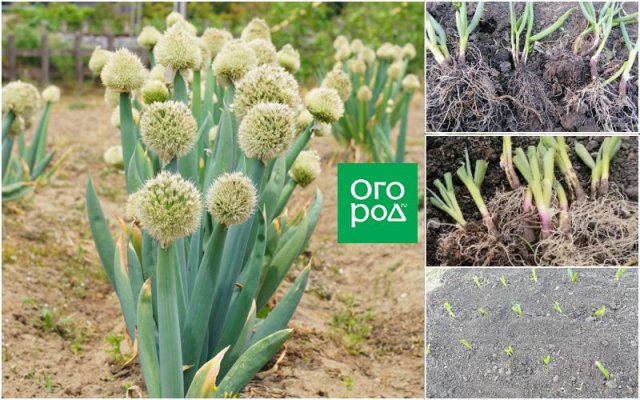Late summer is the perfect time to start dividing perennial onions. To avoid mistakes, use our step-by-step instructions.
If you ask an experienced gardener whether he has already divided perennial onions, the answer will most likely be the following: “Which ones exactly?”
Indeed, in the middle zone, several types of onions are grown as perennials. The most common are:
- onion-batun, or tatarka, or piped onion (Allium fistulosum);
- slime onion, or drooping onion (Allium nutans);
- multi-tiered onion, or horned onion (Allium proliferum);
- shallots, or Ascalonian onions (Allium ascalonicum);
- chives, or onionsAllium schoenoprasum);
- oblique onion (Allium obliquum);
- fragrant onion, or dzhusai, or branched onion (Allium ramosum, Allium odorum) and etc.
Perennial onions are propagated in different ways: by seeds, bulblets, and by dividing the bush. All of the above-mentioned species, except shallots, can be divided and replanted. Shallots are best propagated by seeds or by renewing the planting material every 3-4 years to avoid rot. This is a feature of this onion.
Let’s consider the process of dividing perennial onions step by step, and also mention the features related to each type.
Choose a bright and not too dry place for perennial onions, with loose fertile soil. Pre-dig holes or furrows. Prepare clean, disinfected tools: a shovel and a sharp knife. You will also need mulch.
It is advisable to prepare the soil for planting onions in advance. In the spring, it is worth adding rotted manure (4-5 kg/sq.m) or mineral fertilizers (50 g superphosphate and 30 g potassium sulfate per 1 sq.m) to the future beds. You do not need to do this if you already fertilized the soil last fall.
It is best to divide and plant onions in the ground after rain in cloudy weather. If the day is sunny, it is best to plan the work closer to the evening. Before planting, we recommend keeping the divisions for 20-30 minutes in a weak solution of potassium permanganate or in Fitosporin to prevent fungal and bacterial diseases. Be sure to discard plants with signs of damage by diseases or pests.
The best predecessors for perennial onions are: zucchini, pumpkin, and legumes.
Well, shall we begin?
How to divide perennial chives
It is advisable to divide the onion every 4-5 years to maintain the crop’s yield. The plant is very moisture-loving, and if there is a lack of water, it actively bolts and turns yellow. Therefore, choose soils for onions that retain moisture well, such as loam.
Step-by-step guide
- Carefully dig the healthy leeks out of the soil.
- Using a sharp knife or by hand, divide the rhizome into individual plants (on average 8-10 depending on the variety and age of the bush).
- Select the strongest and healthiest cuttings.
- Trim the roots of each of them to 3-4 cm. You can also shorten the leaves by cutting them to 8 cm.
- Place the divisions in a furrow or holes at a distance of up to 10 cm and carefully cover with soil, leaving the growth points on the surface.
- If necessary, water the soil and mulch with peat or humus.
Carrots and onions are excellent neighbors in the garden, as both protect each other from pests: onion and carrot flies.
How to Divide a Scallion
It is advisable to divide the onion at the age of 2-3 years. Young divisions can be planted not only in the garden bed, but also on the windowsill.
Step-by-step guide
- Dig the bush out of the ground and divide it into 2-3 parts with a knife or shovel.
- Trim the roots a little.
- Plant the selected healthy cuttings in holes at a distance of 20-30 cm between plants.
- Sprinkle with soil and water carefully.
How to Divide Tiered Onions
Multi-tiered onions are most often propagated by bulblets that form on the mother plant. But since the underground mother bulb grows over time, it can also be divided and used as planting material. Without replanting, this crop can live in one place for about 10 years. But if you do not divide the bushes regularly, at least once every five years, the plants will begin to shrink, and the quality of the harvest will noticeably decrease.
Step-by-step guide
- Carefully dig up the multi-tiered onion and inspect the mother bulb for diseases and pests.
- Using a sharp knife, carefully separate healthy onions into individual bulbs.
- Plant the plants at a distance of 12-15 cm from each other. Planting depth – 5-6 cm.
- Water carefully.
- If desired, mulch the soil with a thin layer of sawdust to retain moisture and discourage weed growth.
How to Divide Chives
It is recommended to divide chives every 3-4 years. The procedure is the same as when dividing the previous types of onions: dig up the bush, divide it into several parts so that each division contains 2-3 bulbs, and plant them in pre-prepared holes at a distance of 20-25 cm.
If you have a lot of chives, some of them can be used for food.
How to split a slanted onion
Oblique onions are not so popular among summer residents, but those who grow them note the unpretentiousness and good taste of the crop. Three-year-old plants bring the greatest benefit, as they contain the maximum amount of nutrients. Then it is advisable to divide the oblique onions.
Divide the dug up bulbs into 2-3 new divisions and plant them at a distance of 20-25 cm. The optimal width between rows is 40-50 cm.
How to divide fragrant onions (dzhusai)
Fragrant onions can be planted not only in beds, but also in flower beds. Three-year-old plants are suitable for dividing dzhusai. Carefully dig up the bushes, divide into several bulbs and plant them in small holes at a distance of up to 30 cm.
Be sure to separate your favorite types and varieties of perennial onions to get a rich harvest!














